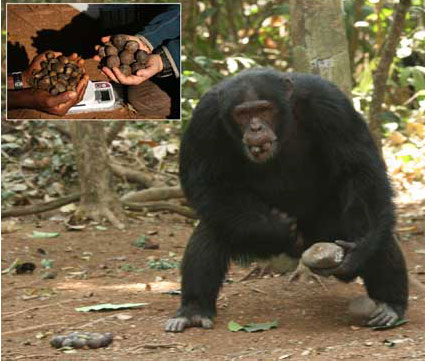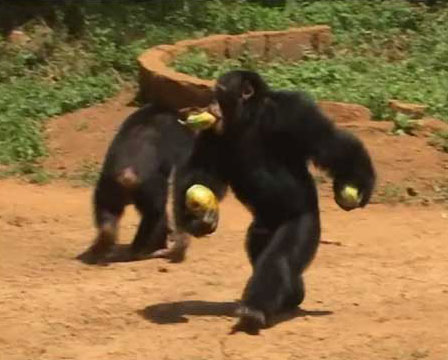HOME » Publications » Chimpanzee carrying behaviour and the origins of human bipedality
Chimpanzee carrying behaviour and the origins of human bipedality
Current Biology, Volume 22, Issue 6, R180-R181, doi: 10.1016/j.cub.2012.01.052
Abstract
Why did our earliest hominin ancestors begin to walk bipedally as their main form of terrestrial travel? The lack of sufficient fossils and differing interpretations of existing ones leave unresolved the debate about what constitutes the earliest evidence of habitual bipedality. Compelling evidence shows that this shift coincided with climatic changes that reduced forested areas, probably forcing the earliest hominins to range in more open settings [1]. While environmental shifts may have prompted the origins of bipedality in the hominin clade, it remains unknown exactly which selective pressures led hominins to modify their postural repertoire to include a larger component of bipedality [2]. Here, we report new experimental results showing that wild chimpanzees walk bipedally more often and carry more items when transporting valuable, unpredictable resources to less–competitive places.
Figure 1-A

Figure 1-B

Bipedal transport of items by wild chimpanzees. (A) Adult male carries both anvil and hammer stones (anvil in left hand, hammer in left foot) and Coula edulis nuts (in mouth and right hand) during an experimental nut-cracking session, before depositing items and starting to crack nuts. Inset shows two species of nuts presented at outdoor laboratory (left: Elaeis guineensis, right: Coula edulis) (see also Supplemental Movie S1). (B) Adult male carries three papayas (one in each hand and one in mouth) during crop-raiding (see also Supplemental Movie S2).
Supplemental Data Document S1. Experimental Procedures and Two Figures
Supplemental Movie S1: Bipedal transport of nuts and stone tools
Video clip shows bipedal transport of nuts and stone tools by adult male chimpanzee at Bossou's outdoor laboratory. He first gathers up a whole pile of 20 Coula edulis nuts, using both hands and mouth, then walks bipedally to set of stone tools provided, where he first selects stone anvil (carried in left hand) then stone hammer (carried in left foot). He then continues to walk bipedally, moving to different spot, where he stops to process nuts and to consume their kernels. While walking bipedally during final stage of transport, he uses three limbs, as well as mouth, to carry nuts and stone tools.
Supplemental Movie S2: Transport of three papayas by adult male chimpanzee at Bossou
Video clip shows transport of three papayas by adult male chimpanzee at Bossou. Fruits were collected from small orchard in village and transported back to forest. Items are carried in both hands and mouth. Transport includes quadrupedal, tripedal and bipedal locomotion, with 17 of 38 steps being bipedal.
Full Text
PDF Download Please refer to the terms of use before downloading.





